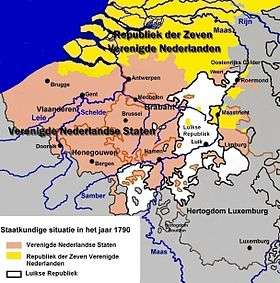Republic of Liège
The Republic of Liège (French: République liégeoise) was a short-lived state centred on the town of Liège in modern-day Belgium. The republic was created in August 1789 after the Liège Revolution led to the destruction of the earlier ecclesiastical state which controlled the territory, the Prince-Bishopric of Liège. It coexisted with the even more short-lived revolutionary state, the United States of Belgium, created by the Brabant Revolution of 1789, to the north. By 1791, the forces of the republic had been defeated by Prussian and Austrian forces and the Prince-Bishop was restored.
Revolution
On 18 August 1789, Jean-Nicolas Bassenge and other democrats arrived at the Hôtel de Ville of Liège. They demanded the dismissal of current magistrates in favour of two popular burgomasters: Jacques-Joseph Fabry and Jean-Remy de Chestret. The citadel of Saint Walburge fell into the hands of the rebels. The Prince-Bishop, César-Constantin-François de Hoensbroeck, was brought back from his Summer Palace in Seraing to ratify the nomination of the new officials and to abolish the unpopular Règlement de 1684. Several days later, the Prince-Bishop fled to the city of Trier in modern Germany. The Holy Roman Empire condemned the Liège revolution and demanded the restoration of the Ancien régime in the prince-bishopric.
The radical mood in Liège led to the proclamation of a republic, two years before France.
Law
One of the first acts of the republic was the introduction of the "Declaration of the Rights of Man and Citizen of Franchimont" on 16 September 1789. The document was heavily influenced by the French Declaration of the Rights of Man and of the Citizen introduced in August 1789 but contained several important differences:
- Article 3: Sovereignty resides in the people [and not the nation]
- Article 10: Every citizen has freedom of thought and opinion [without restriction]
- Article 17 of the French declaration concerning property is absent because civil and legal rights in Liège relative to property had been in force since 1196.
Further reading
- Droixhe, Daniel (2007). Une Histoire des Lumières au Pays de Liège: Livre, Idées, Société. Liège: Université de Liège. ISBN 978-2-87456-036-1.
- Harsin, Paul (1955). La Révolution liegeoise de 1789. Brussels: Notre Passé. OCLC 560799527.


